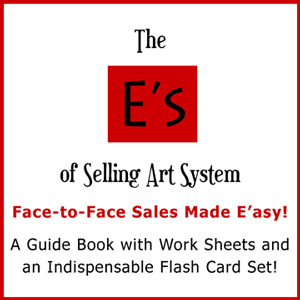You may have seen the term “value proposition” show up here and there. It’s one of the golden rules of business. You must have a “strong” value proposition. It’s hammered into the brain of every business school graduate. It’s considered the foundation of a successful business.
And since I want my artist community to be forever more successful in their careers in the arts, it’s time to tackle this concept.
First, let’s define “value proposition” in its most general terms:
Next, let’s examine just a few things to consider to begin creating a value proposition. This might apply to the entire business or to a particular item you are selling.
- Why should someone do business with you?
- Which features and benefits of your product or service are of value to your buyer?
- What problem, if any, will be solved (often known as a “pain point”) by your product or service?
- What is uniquely available from you that makes you a better choice than your competition?
- And the overwhelmingly best question is also my favorite “mantra”: What’s in it for them?
But hold on! This is Art! This is not the same as other “stuff” people buy, right?
If that was what kept rolling around in your mind as you were reading this, then give yourself a gold star. You are exactly right. Art is not the same kind of purchase. But there is one thing that art has in common with every other purchase made and that is value. People from all walks of life and income levels make a purchase only when the value is clearly felt. The purchase must add value to our lives and provide benefits that we need.
For example, I just bought sheets online. The value for me was only achieved when they had really deep pockets to fit my very deep mattress. That was the “feature” that mattered. Without that feature, I would not benefit. The sheets could have been made by monks from silk hand spun on a mountaintop, but if they weren’t deep enough to fit my mattress who cares. And yet, this was a fact that I often had a hard time discovering easily from Amazon’s merchants.
Clearly, art purchases don’t fit neatly into the features and benefits the same way sheets do. But art still needs to appear and feel like it is providing value.
What is valuable to your art buyers?
The “value” when we purchase art, especially directly from the creator of the art object, is much more complicated, emotionally charged, and nuanced. Let’s break it down. Let’s put this into the context of an art purchase.
A value proposition for artists & makers means making it clear what features and benefits you provide with ownership of your art. In other words, make it clear to collectors that they will get all the good feelings they deserve. Click To Tweet
Unlike Uber or Maytag, you are not trying to beat out the competition. At least not directly. There is no Consumer Reports team who is putting a Norman Rockwell up against a Picasso to judge which one is the better choice. So that part of the normal Value Proposition is null and void.
What you do offer is less tangible, but more exciting. You offer people an opportunity to feel they are part of a greater or more unique ownership experience. As different as an art purchase is, there are still certain norms that apply.
Here are some areas worthy of highlighting as having unique “value” to the buyer of fine arts and crafts.
- Do you offer a variety of sizes or colors?
- If you are a jewelry artist, do you offer a clasp that is easy to use for older hands?
- If you are a 2D artists, do you offer to create a virtual look at how your art will look on their walls?
- Do you offer commissions?
- Do you offer a satisfaction guarantee?
- Do you offer free shipping?
This list can go on and on, but here’s what you need to consider: whatever you feature as a benefit of ownership or doing business with you has value. Treat it as such in every way possible. Highlight the value every chance you get.
In other words, state the obvious. You might be surprised at how often the obvious is not front of mind of the buying public. I am shocked at how many artists don’t put a sign in their display (or on their website) that they ship worldwide.
I know it seems obvious, but if someone has never in their life bought something that needs to be shipped, especially to international destinations, they need reminding. And it’s a further benefit to you to have that sign because “subliminally” it also says “you can buy this because I ship”.
Revisiting the list for a moment, what can you say or demonstrate quickly to someone who is considering your art? If you do offer a variety of colors or sizes and you know that makes a difference, you might not wait for someone to go to your shopping cart to learn that fact.
Continuing with that list, what about your easy to use clasp? Should you have a 20-second video that shows how simple it is to use? And what about commissions. You might need a full and separate page (and a hand-out for in-person events) to make sure the client understands and feels comfortable about the process.
The bottom line: if you offer certain services or choices as “standards” of your operation and you know that the majority of the public needs that information to make an informed decision, then make that clear to them as soon as possible. In person or online, they need to know the value of your proposition.
Of course, this implies that you have actually identified what is valuable. Back to my sheet purchase, many sellers apparently didn’t know that was important. Perhaps they “assumed” their audience would assume the sheets had deep pockets? Are you assuming anything?
The uniquely positioned value of art
Because you not selling a commodity, you need to position yourself as being valuable because of the very fact that you are not an ordinary purchase. Even art that is “functional”, like a hand-thrown ceramic coffee mug, it’s still not some massively produced and globally distributed widget. Its origins are your heart and soul. And for many of you, it’s also one of a kind. Isn’t that already the “value”? Isn’t that what your buyers want to be a part of and are invested in emotionally when they bring the art into their lives?
I know this part can be hard. I know the ongoing conundrum for artists that lurks behind the surface. You run on top of a very thin fence line. It’s already very personal to put your work in front of complete strangers online and offline. It’s scary to say out loud what you want from the world. It’s even scarier to announce what your value is to the world.
Are you ignoring your best features?
In the end, you need to pay attention to what draws people in and keeps them in. Think hard about what your value is as an artist and what value your collectors receive when purchasing your work. To help you think through this concept, I have created a PDF file.
For anyone on my email list, this article announcement that showed up in your inbox included a PDF for you to download. If you are not on my list, please email me with a request to join and I will send you a link to join along with the PDF to download. Email me directly with this link.
And as always, I hope you will add to this in the comments. How do you describe your value to your potential buyers? What do you do on your website to address this issue?







Arggggghhhh this is a killer…..your words in the PDF ….. “If you doubt your worth, even just a tiny bit, you will have a hard time creating a Value Proposition that you are willing to share..”
I fall at the first hurdle.
I think I need your help.
You know I stand ready to skype with you again, Samantha. But self-doubt is hard for someone else to combat FOR you. I don’t have any magic words. Yes, my golden words are helpful, but you still need to believe in yourself. Again, as I say in so many different ways to this community: You are impacting the world in ways that no other creative soul can. It’s your vision and your passion that people fall in love with and enjoy for years to come. Own that. Own your collector’s belief in you. TRUST THEM. They know your value. Believe them and then you will begin to believe in yourself.
Great article. This is something that in my head, I knew I needed to do, but you are right,it is hard. I must get to work on this idea. Thanks so much for the worksheet!
I think you have my Guidebook – The E’s of Selling Art System? If you haven’t done the worksheets in that guidebook, that might be a great way to kickstart, too. I must say, though: You are pretty on point with most of your marketing and messaging, Susan. As always, the people who are always trying to improve are the people who have the least to improve upon.